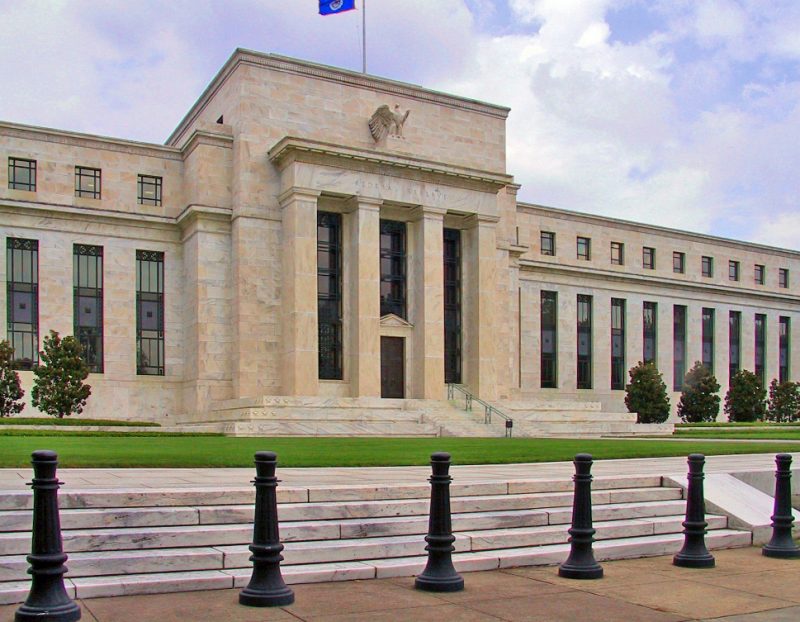Oops, they did it again. Even though the housing market has been in a depressed state for an extended period of time and even though economic conditions are slowing down all over the country, the Federal Reserve has once again refused to lower interest rates. What in the world are they thinking? I certainly share President Trump’s frustration with the Fed. Central banks all over the world have been cutting rates, but our central bank just won’t budge. Have Fed officials gone completely insane, or are they purposely trying to destroy the U.S. economy?
Those that have been following my work for an extended period of time already know that I am not a fan of the Federal Reserve at all. And now we have another very clear example of the Fed’s lack of competence…
The Federal Reserve said Wednesday it’s keeping its benchmark interest rate unchanged, citing elevated uncertainty over the nation’s economic outlook.
The decision to hold rates steady marks a continuation of the Fed’s “wait-and-see” strategy this year, as it monitors the impact of the Trump administration’s tariffs on consumer prices.
There were two Fed governors that did not agree with this decision. This was the first time since 1993 that more than one Fed governor has dissented…
For the first time since 1993 more than one Fed governor voted against the Fed chair Jerome Powell and the committee’s majority decision.
The dissenters – governors Christopher Waller and Michelle Bowman – were both appointed by Trump and like the President support cutting rates.
For months Trump has pressured Powell to cut rates – currently between 4.25 and 4.5 percent – threatened to fire him, appoint a shadow chair and even harangued him over the cost of improvements to the Fed’s offices.
There are some experts that argue that we need to continue to keep interest rates at elevated levels in order to get inflation under control.
I definitely acknowledge that our seemingly endless cost of living crisis is a major concern.
But what about the housing market?
It has been in a depressed state for a long time.
Last year, sales of existing homes in the U.S. fell to the lowest level that we have seen since 1995…
Sales of existing homes in the US fell last year to the lowest level in almost three decades, as sky-high home prices and elevated mortgage rates squeezed home buyers.
Sales of previously owned homes, which make up the vast majority of the market, totaled 4.06 million in 2024, the National Association of Realtors said Friday. That’s the lowest level since 1995 and slightly below 2023’s similarly anemic levels.
And this year, sales of existing homes are expected to be even lower than they were last year…
Sales volume for existing homes, previously projected to grow slightly this year compared with 2024, is now expected to fall 1.5% annually, to just 4 million transactions.
That would mark the slowest year for existing-home sales since 1995, when they registered 3.8 million. Home sales were also at their lowest since 1995 in both 2023 and 2024, according to the National Association of Realtors®.
Things were not even this bad during the Great Recession in 2008 and 2009.
The primary reason why homes are not selling is because interest rates are way too high.
Is the Fed just going to sit there and watch the life get squeezed out of one of the most important pillars of our economy?
Of course there are many pundits that are pointing to today’s GDP number as evidence that the overall economy is doing well…
Gross domestic product, a sum of goods and services activity across the sprawling U.S. economy, jumped 3% for the April through June period, according to figures adjusted for seasonality and inflation.
That topped the Dow Jones estimate for 2.3% and helped reverse a decline of 0.5% for the first quarter that came largely due to a huge drop in imports, which subtract from the total, as well as weak consumer spending amid tariff concerns.
That number looks pretty good until you realize that it was artificially boosted by a massive decline in imports.
In fact, we are being told that a huge drop in imports somehow added 5.2 percentage points to our GDP during the second quarter…
With Trump’s double-digit tariffs looming, American retailers and manufacturers raced to order foreign goods early in the year before the levies took effect. That led to an unprecedented flood of imports, which must be subtracted from GDP – the goods that consumers, companies and the public sector bought – because they’re made overseas.
Since those purchases were pulled forward, companies didn’t need to order as many goods from other countries last quarter and imports plunged 30.3%, reversing the 37.9% rise that dampened output earlier and bolstering U.S. growth. As a result, those foreign shipments added 5.2 percentage points to growth after subtracting a whopping 4.7 points in the January-March period.
If you took away the 5.2 percentage points that were added to our GDP due to falling imports, economic growth would have been deeply negative last quarter.
And based on all of the other economic data that we have been getting, that would make all the sense in the world.
We see a similar thing going on with the official employment numbers that the government has been giving us.
Thanks to the “birth-death model”, the U.S. has supposedly added 614,000 jobs so far this year.
But if you take away the “birth-death model”, the U.S. has actually lost 62,000 jobs so far this year…
So far this year, the net birth-death model has converted what would have been a 62,000-job decline in not seasonally adjusted nonfarm employment into a 614,000-job gain. In the note cited above, Bloomberg Economics estimated that the model and other factors have been artificially boosting seasonally adjusted gains of 130,000 a month so far this year by about 80,000 a month. If even roughly correct (Bloomberg Economics’ payroll overcount estimates as of June 2024 were about twice as big as what the BLS eventually reported), this would mean another sharp downward revision next February, the fifth in the last seven years.
I don’t have any confidence in the numbers that the government gives us at this stage.
When President Trump called them “fake” prior to the election, he was right on target.
One recent survey found that 70 percent of Americans are feeling “anxiety and depression” due to the finances.
That wouldn’t be happening if our economy really was in good shape.
Unfortunately, as long as the Federal Reserve keeps interest rates at elevated levels it is going to be a real struggle to turn things around.
Michael’s new book entitled “10 Prophetic Events That Are Coming Next” is available in paperback and for the Kindle on Amazon.com, and you can subscribe to his Substack newsletter at michaeltsnyder.substack.com.
About the Author: Michael Snyder’s new book entitled “10 Prophetic Events That Are Coming Next” is available in paperback and for the Kindle on Amazon.com. He has also written nine other books that are available on Amazon.com including “Chaos”, “End Times”, “7 Year Apocalypse”, “Lost Prophecies Of The Future Of America”, “The Beginning Of The End”, and “Living A Life That Really Matters”. When you purchase any of Michael’s books you help to support the work that he is doing. You can also get his articles by email as soon as he publishes them by subscribing to his Substack newsletter. Michael has published thousands of articles on The Economic Collapse Blog, End Of The American Dream and The Most Important News, and he always freely and happily allows others to republish those articles on their own websites. These are such troubled times, and people need hope. John 3:16 tells us about the hope that God has given us through Jesus Christ: “For God so loved the world, that he gave his only begotten Son, that whosoever believeth in him should not perish, but have everlasting life.” If you have not already done so, we strongly urge you to invite Jesus Christ to be your Lord and Savior today.

